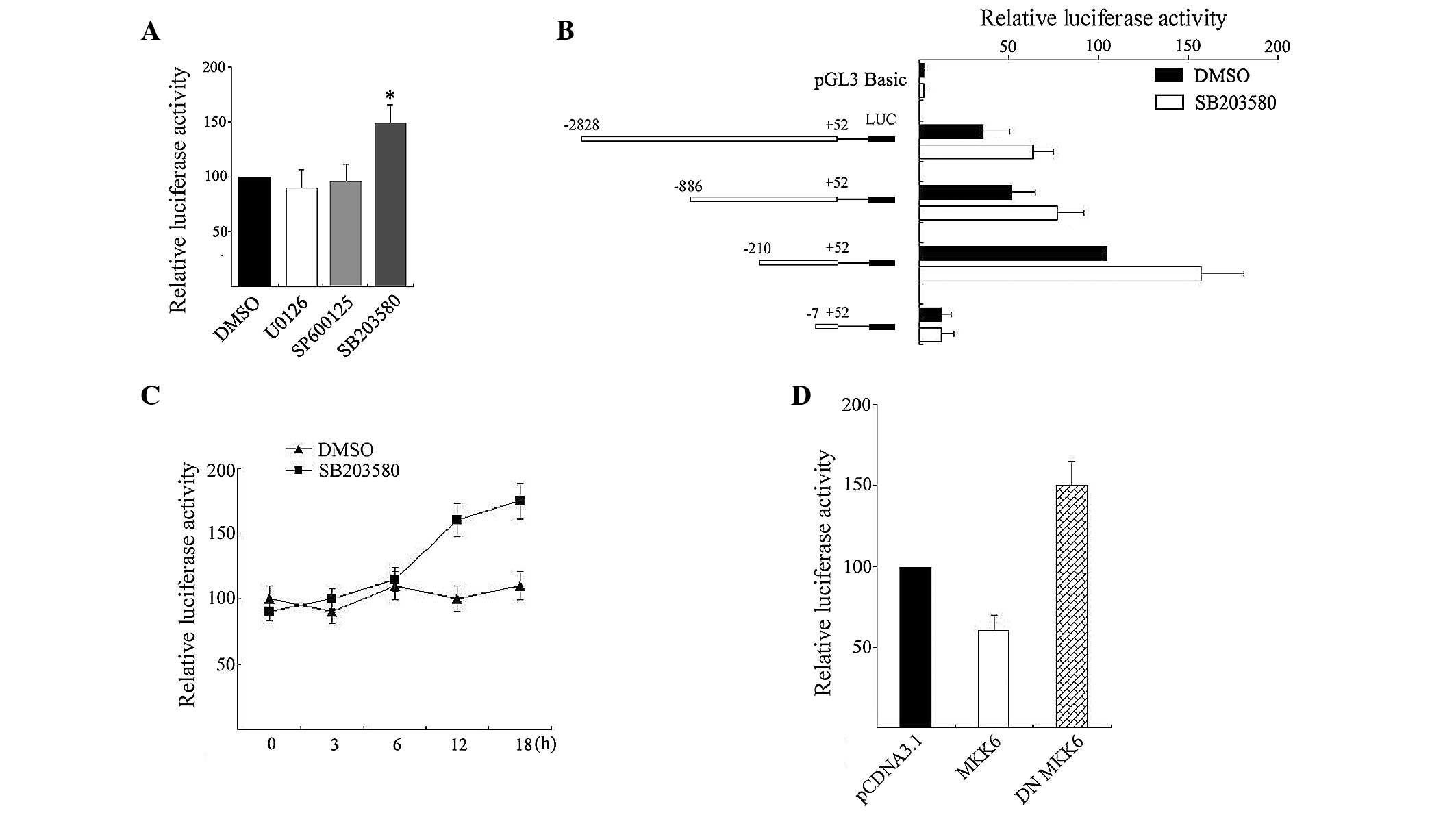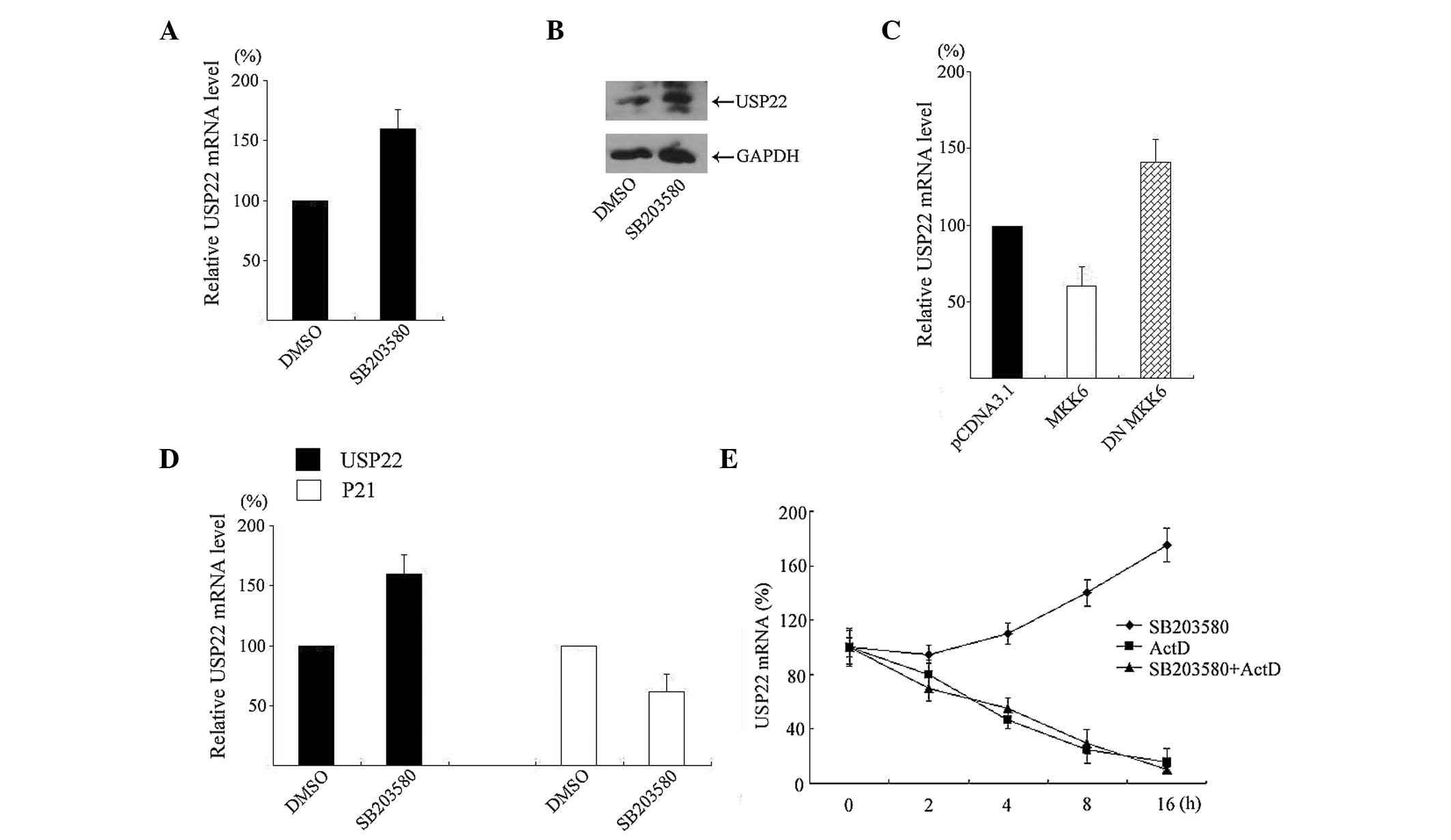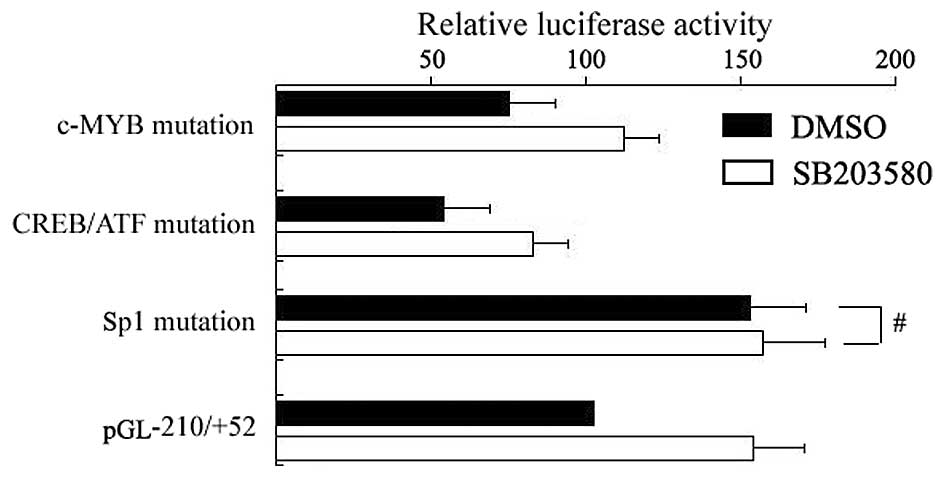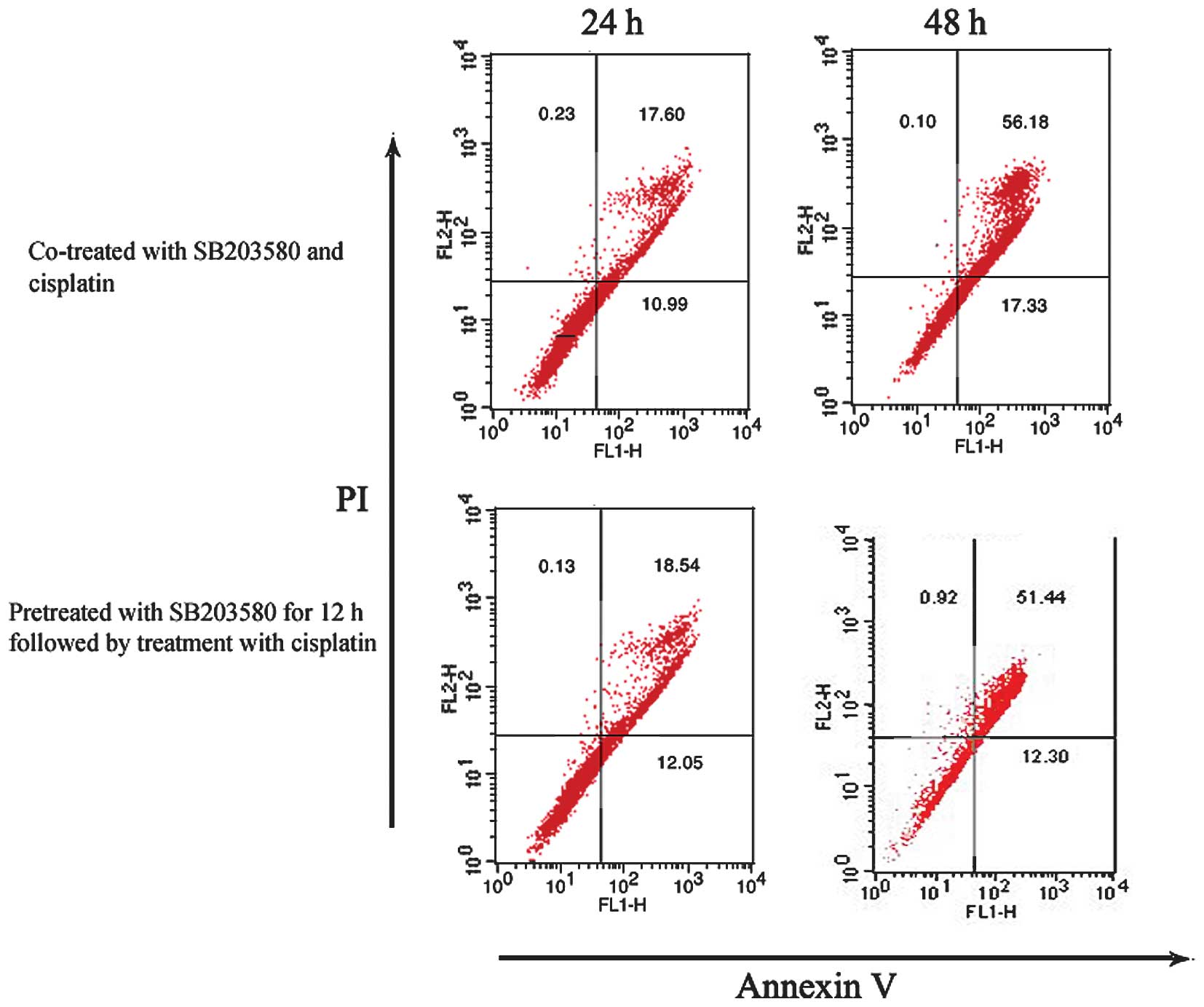p38 mitogen‑activated protein kinase inhibits USP22 transcription in HeLa cells
- Authors:
- Published online on: April 16, 2015 https://doi.org/10.3892/br.2015.450
- Pages: 461-467
Abstract
Introduction
Ubiquitin-specific processing enzyme 22 (USP22) is a novel deubiquitinating enzyme that can cleave ubiquitin (Ub) from Ub-conjugated protein substrates (1). As the subunit of the human SAGA coactivator complex, USP22 is linked to the regulation of gene transcription by deubiquitinating histones H2A and H2B (2,3). In addition, USP22 deubiquitinates intracellular protein, including the shelterin protein telomeric repeat binding factor 1 (4), the histone deacetylase sirtuin 1 (5) and the far upstream element-binding protein 1 fructose-1,6-bisphosphatase 1 (4), and therefore performs an extensive physiological function. A murine study showed that USP22 also regulates embryonic stem cell differentiation (6). In humans, the USP22 gene is located on chromosome 17, consists of 14 exons, and is transcribed and produced broadly across various tissues (7). Of note, elevated levels of USP22 have been identified in numerous types of human cancer, including colorectal (8) lung (9) and breast cancer (10). USP22 has been indicated in tumorigenesis. Deletion of USP22 leads to the accumulation of cells in the G1 phase of the cell cycle (2). For these reasons, USP22 is a putative cancer stem cell marker. Reducing the rate of USP22 expression may be a suitable target for cancer therapy (11). However, the mechanisms that lead to USP22 transcriptional activation, particularly in the human tumor cells, remain unknown.
Previously, USP22 transcription was activated by mitogen stimulation or viral infection in normal T and B lymphocytes (12), suggesting the regulation of USP22 gene expression occurs mainly at the transcriptional level. However, the mechanism in which signal transduction pathways regulate USP22 transcription is unclear. It is well-known that activation of the mitogen-activated protein kinase (MAPK) pathways is the main downstream event in response to mitogen stimulation. Three activated subgroups of MAPKs: Extracellular signal-regulated kinases (ERKs), p38 MAPK and c-Jun N-terminal kinases (JNKs), regulate diverse cellular responses, including cell proliferation, differentiation, survival, the inflammatory response and even cell death (13).
In the present study, p38 MAPK was involved in the regulation of USP22 transcription, but ERKs and JNKs were not. The chemotherapeutic agent cisplatin suppressed the USP22 gene partly through p38 MAPK. These results provide novel insights on the molecular mechanisms underlying USP22 expression.
Materials and methods
Cell cultures
Human cervical carcinoma (HeLa) cells were obtained from the Type Culture Collection of the Chinese Academy of Sciences (Shanghai, China) and were cultured in Dulbecco's modified Eagle's medium from Invitrogen (Carlsbad, CA, USA) supplemented with 10% fetal bovine serum at 37°C in a 5% CO2 incubator. Cisplatin and MAPK inhibitors U0126, SB203580 and SP600125 were from Sigma-Aldrich (St. Louis, MO, USA).
Plasmid constructs
The USP22 promoter fragments inserted into pGL-3 were constructed as described previously (14). Site-directed mutagenesis was carried out within the USP22 basic promoter p-210/+52 according to the manufacturer's instructions for the MutanBEST kit (Takara Bio Inc., Otsu, Shiga, Japan). Mutagenic primer pairs used for the polymerase chain reaction (PCR) amplification included 5′-GTAGCGTAATCTCCGTCCGC-3′ for the CREB/ATF-binding site mutagenesis, 5′-CCTGTAGGCTCTGGGTAGAC-3′ for the MYB-binding site mutagenesis, 5′-GGATCGGTGCCTGCCTTGCA-3′ for the Sp1-binding site (−7/−12) mutagenesis (complementary reverse primers are not shown, and mutated nucleotides are underlined). All the mutations were confirmed by DNA sequencing. The MAPK kinase 6 (MKK6) expression plasmid and dominant negative MKK6 (DN MKK6) plasmid were provided by Professor Jiahuai Han of Xiamen University (Xiamen, Fujian, China).
Transfections and dual luciferase reporter assay
Cells (1×104) were plated in 24-well plates 12 h before transfection with 0.5 µg of various USP22 promoter constructs and 0.1 µg pRL-TK (Promega Corp., Madison, WI, USA) using Lipofectamine 2000 (Invitrogen) in each well. Twenty-four hours after transfection, cells were was hed in phosphate-buffered saline and lysed for 30 min at room temperature using the passive lysis buffer (Promega Corp.). Luciferase activity was determined using the dual luciferase reporter assay system (Promega Corp.). The normalized luciferase activity was expressed as the ratio of firefly luciferase activity to Renilla luciferase for each sample. All the transfection experiments were repeated four times.
Total RNA isolation and quantitative PCR (qPCR)
Total RNA from cells treated with agents was prepared using TRIzol according to the manufacturer's instructions (Invitrogen). RNA was reverse-transcribed with oligo-dT primers using an RNA PCR kit (AMV) ver. 3.0 (Takara Bio Inc.), and the cDNA fragments were analyzed by qPCR using the SYBR-Green PCR Master mix (Toyobo Co., Ltd., Osaka, Japan) on an ABI 7500 real-time PCR System (Applied Biosystems, Foster City, CA, USA). USP22 primer pairs were: Forward, 5′-ACCACCACGCTCACGGACTG-3′; and reverse, 5′-TTGGCTGAGTGTTCAAATCG-3′; P21 primer pairs were: Forward, 5′-GCAGATCCACAGCGATATCC-3′; and reverse, 5′-CAACTGCTCACTGTCCACGG-3′. GAPDH primers were: Forward, 5′-AGAAGGCTGGGGCTCATTTG-3′; and reverse, 5′-AGGGGCCATCCACAGTCTTC-3′.
Western blot analysis
Cells were lysed with 1X SDS sample buffer. Protein was separated by 10% SDS-PAGE and electroblotted onto nitrocellulose membrane. The membrane was subsequently incubated with anti-USP22 antibody or anti-GAPDH antibody (Santa Cruz Biotechnology, Inc., Dallas, TX, USA) and developed using the electrochemiluminescence system (Pierce Biotechnology, Inc., Rockford, IL, USA), according to the manufacturer's instructions.
Flow cytometry
Cells (1×105) were seeded in 6-well plates overnight and subsequently SB203580 or dimethyl sulfoxide (DMSO) was added. After 12 h, the medium was changed for medium containing cisplatin for a further 12 or 24 h incubation. The cells were harvested by trypsinization, was hed with 1X PBS and resuspended in 50 µl of 1X PBS. Cell death was assessed using flow cytometry (BD Biosciences, Franklin Lakes, NJ, USA) following staining with fluorescein isothiocyanate-Annexin V and propidium iodide.
Statistical analysis
Numerical data are presented as the mean ± standard error of the mean. Statistical differences between sample means were determined using the unpaired, two-tailed Student's t-test. The significance level was set at α<0.05, and therefore, P<0.05 was considered to indicate a statistically significant difference.
Results
p38 MAPK regulates USP22 promoter activity
Pharmacological reagents that inhibit MAPK pathways with different specificity were used to determine whether MAPK signaling is involved in the regulation of USP22 expression: U0126, SB203580 and SP600125. These selectively inhibit ERK1/2, p38 MAPK and JNK, respectively. HeLa cells were transfected with the reporter construct, pGL-210/+52, which contains the USP22 basic promoter region from −210 to +52 (14). The transfected cells were cultured for a further 12 h in the presence of 2 µM U0126, 2 µM SB203580, 10 µM SP600125 and 0.1% DMSO as blank controls, and luciferase activity was measured. As shown in Fig. 1A, incubation of 2 µM SB203580 resulted in an ~150% induction of luciferase activity relative to DMSO (P<0.05). However, treatment of SP600125 and U0126 did not affect the luciferase activity in the tested cells (P>0.05).
To further confirm the induction effects and localize the region in the promoter responsible for this enhancing effect by SB203580, reporter vectors containing a series of 5′ terminal deletion constructs of the USP22 promoter were transfected into HeLa cells and treated with 2 µM SB203580 for 12 h. Luciferase activity showed that SB203580 enhancing USP22 promoter activity was observed with constructs pGL-2828/+52, pGL-886/+52 and pGL-210/+52, but not with construct pGL-7/+52 (Fig. 1B), suggesting a certain degree of promotion by SB203580 may be mediated through response elements located within the −210/−7 domain. Subsequently, pGL-210/+52 was transfected and incubated with SB203580 for different periods. As shown in Fig. 1C, SB203580 induced USP22 promoter activity but this was not an early event. Significant increases in promoter activity (~150%) occurred after 12 h incubation.
MKK6 phosphorylates and activates p38 MAPK (15). To confirm whether MKK6 regulates USP22 expression, DN MKK6 and pGL-210/+52 were transiently co-transfected into HeLa cells. A luciferase assay showed that expression of DN MKK6 increased transcription of USP22 by 150%, which was similar to the action of SB203580. By contrast, forced expression of a constitutively active MKK6 had a significant inhibitory effect on USP22 promoter activity (Fig. 1D). All these results demonstrated that p38 MAPK is involved in the regulation of USP22 promoter activity.
p38 MAPK regulates endogenous USP22 expression
As the p38 MAPK pathway is involved in regulating USP22 promoter activity, the effects of p38 MAPK on endogenous USP22 expression were assessed. As shown in Fig. 2A, treatment of HeLa cells with 2 µM SB203580 for 12 h significantly increased USP22 mRNA expression by ~160% as examined using qPCR. Consistent with the PCR results, USP22 protein levels were also increased by SB203580 incubation (Fig. 2B).
MKK6 and DN MKK6 were transfected into HeLa cells and USP22 mRNA expression was quantitated. As shown in Fig. 2C, forced expression of MKK6 decreased endogenous USP22 mRNA and DN MKK6 increased the expression.
p21, a cyclin-dependent kinase inhibitor, is repressed by USP22 (4). For this reason, levels of p21 mRNA were measured in response to SB203580. As shown in Fig. 2D, SB203580 treatment for 12 h decreased p21 mRNA expression in HeLa cells.
To further determine whether p38 MAPK influences USP22 mRNA stability in HeLa cells, actinomycin D was used to block de novo mRNA transcription. The level of mRNA was determined at different points in time using qPCR. When cells were treated with actinomycin D, the half-life of USP22 mRNA was between 4 and 5 h. When SB203580 was added 12 h before actinomycin D treatment, the half-life of USP22 mRNA did not change significantly and was similar to that in the cells without SB203580 treatment (Fig. 2E), excluding the possibility that p38 MAPK influences USP22 mRNA stability.
p38 MAPK regulates USP22 via the Sp1 binding site
As mentioned above, the region responsible for enhancing USP22 promoter activity using SB203580 is located within the −210/−7 domain. TFSEARCH analysis showed there to be several potential transcription factor binding sites within this region, including an MYB, a CREB/ATF and a Sp1 binding site. To characterize the involvement of particular cis elements in response to SB203580, wild-type and mutant reporter gene constructs of the USP22 promoters were generated. After plasmids were transfected into HeLa cells, SB203580 was incubated for another 12 h. As shown in Fig. 3, mutation of the MYB and CREB/ATF binding sites did not disrupt the enhancing effect of USP22 promoters by SB203580. However, mutation of the Sp1 binding site (−7/−13) resulted in increased basal USP22 promoter activity and abrogated the enhancing promoter activity treated by SB203580 (Fig. 3), suggesting SB203580 elicits promotion of USP22 transcription through the Sp1 binding site.
Cisplatin represses USP22 expression through p38 MAPK
A previous study has shown that p38 MAPK can be activated by several anticancer reagents, such as cisplatin (16). Whether cisplatin can suppress USP22 expression was explored. HeLa cells were treated with 30 nM cisplatin for 0, 6, 12 and 24 h and USP22 expression at the mRNA level was analyzed using qPCR. As shown in Fig. 4A, cisplatin can induce an extremely significant decrease in USP22 mRNA expression in HeLa cells. Significant changes can be observed after 6 h of treatment (52% inhibition).
Subsequently, HeLa cells were co-treated with cisplatin and SB203580 for 12 h. As shown in Fig. 4B, cisplatin decreased USP22 promoter activity and this suppression was mostly restored in HeLa cells by treatment with 2 µM SB203580. Similarly, SB203580 partially restored the cisplatin-induced decrease in USP22 mRNA (Fig. 4C). These results indicate that cisplatin can suppress USP22 expression at the transcriptional level and this suppression is possibly mediated by p38 MAPK.
SB203580 did not protect HeLa cells from cisplatin-induced apoptosis
As overexpression of USP22 may be a factor for therapeutic resistance, the role of p38 MAPK/USP22 signaling was determined in the survival of cancer cells exposed to cisplatin. HeLa cells were treated with cisplatin and SB203580 in two ways and were subsequently analyzed by flow cytometry. One group of cells was pretreated with SB203580 for 12 h and subsequently cisplatin was added and allowed to incubate for another 12 or 24 h. The other was co-treated with SB203580 and cisplatin for 12 or 24 h. As shown in Fig. 5A, pretreatment or co-treatment of HeLa cells with SB203580 did not result in less cisplatin-induced apoptosis as determined by Annexin V staining. These results suggest that SB203580-induced promotion of USP22 expression did not protect HeLa cells against cisplatin-induced apoptosis.
Discussion
Considering the crucial role of USP22 in carcinogenesis and tumor progression, p38 MAPK regulation of USP22 may have important implications. Studying signaling pathways that regulate USP22 expression may lead to identification of new therapeutic targets for cancer therapy. The present study reported that p38 MAPK acts upstream of USP22 and plays a negative role in USP22 transcription. p38 MAPK was found to regulate USP22 transcription via a Sp1 binding site. In addition, cisplatin suppressed USP22 expression in part through p38 MAPK.
One of the findings of the present study is that USP22 transcription is controlled by p38 MAPK. Pharmacological inhibitors were used and results showed that the inhibitor of p38 MAPK enhanced USP22 promoter activity under culture conditions but ERKs and JNKs did not. The further multiple experimental results leading to this conclusion are as follows: i) SB203580 promoted endogenous USP22 mRNA expression, ii) transfection of the p38 activator MKK6 repressed USP22 promoter activity and endogenous mRNA expression, and iii) transfection of the p38 inhibitor DN MKK6 enhanced USP22 promoter activity and endogenous mRNA expression. All these results indicated that p38 MAPK acts as the upstream regulator in regulation of USP22 transcription. The p38 MAPK pathway is an important regulator of numerous cellular responses and the target genes regulated by activated p38 MAPK are complex. Initially, cytokine genes, such as tumor necrosis factor-α and interleukin-10 (IL-10), have been described as target genes promoted by p38 MAPK in T cells and monocytes following stimulation (17,18). Recently, p38 MAPK has received increasing attention as a tumor suppressor and its activation suppresses oncogenesis in cancer cells with different patterns (19). For example, BMI-1, one of 11 death signature genes as USP22, is reported to be downregulated by p38 MAPK by posttranscription modification (7). Cyclin D1, the oncogene, is also negatively regulated by p38 MAPK at the transcription level (20). In the present study, the possibility that p38 MAPK affects the stability of USP22 mRNA was excluded and p38 MAPK was confirmed to regulate USP22 at the transcriptional level. Results showed that in response to SB203580 treatment, expression of USP22 and the key regulator of cell cycle, p21, exhibited the inverse trend. A previous study has demonstrated that p38 MAPK participates in p21 upregulation, subsequently inhibiting cell growth (21). It is not fully understood how activated p38 MAPK can upregulate p21 expression. One study showed that p38 MAPK stabilizes p21 mRNA (22). Another study reported that p38 MAPK can enhance p21 expression by promoting the transcriptional elongation (23). USP22 acts upstream of p21 and represses p21 expression (4) and the present results indicate that expression of the p38 MAPK promoter p21 may take place partially through USP22 downregulation.
p38 MAPK regulation of gene expression is mediated by the activation of a wide range of protein kinases, transcription factors and other proteins. The present study showed that p38 MAPK-induced repression of USP22 is mediated by a Sp1 binding site. Bioinformatic analysis showed that the 5′ flank region of USP22 is a typical feature of the TATA-less promoter and several DNA motifs are within the basic USP22 promoter, including an Sp1, a CREB/ATF and a c-MYB binding site. Mutation of these sites has been confirmed to lead to USP22 promoter activity changes (data not shown). The present study showed only the Sp1 binding site (GGGCGG) ahead of the transcription start site (−7 to −13) to be responsible for SB203580 treatment, as mutations at this site enhance USP22 promoter activity and abolish the effects of SB203580 on USP22 promoter activity. Previous studies have shown that the GGGCGG sequence is involved in regulation of USP22 expression and is specifically bound by Sp1. Despite its history, transcription factor Sp1 is activated by phosphorylation in response to p38 MAPK. For example, it has been reported that p38 MAPK regulation of IL-10 promoters activity is via Sp1. The mechanisms by which p38 MAPK activates Sp1 to regulate USP22 transcription will be discussed in a future study.
p38 MAPK activation is also necessary for the suppression of cancer cell growth as initiated by a variety of anticancer agents, including cisplatin (24). In the present study, cisplatin was used to activate p38 MAPK in HeLa cells. Treatment of these cells with cisplatin suppressed production of USP22 mRNA, which was mostly accounted for by decreased promoter activity. Cisplatin exerts its cytotoxic properties by DNA strand-cross links, therefore activating downstream signaling cascades, which ultimately induce apoptosis. In the present study, cisplatin was found to repress USP22 expression via the p38 MAPK pathway; SB203580 treatment antagonized cisplatin to repress USP22 expression, and the decrease of the USP22 promoter by cisplatin was also abolished by disruption of the Sp1 binding site. It has been proved that p38 MAPK is the universal sensor for cisplatin presence and the activation of p38 MAPK is required for apoptosis. Considering the p38 MAPK downregulation of USP22, it is not difficult to understand that cisplatin treatment suppresses USP22 expression.
USP22 is considered as the putative cancer stem cell marker and its overexpression has been associated with therapy resistance. Therefore, it appears that enhanced USP22 expression by SB203580 may exert anti-apoptotic effects in theory. However, previous studies showed that the role of SB203580 on cisplatin-induced apoptosis in tumor cells remains controversial. Numerous studies showed that the p38 MAPK inhibitor, SB203580, protected cells from cisplatin-induced apoptosis. However, several studies showed that SB203580 did not reverse cell apoptosis but sensitized cells to apoptosis. In the present study, pretreatment or co-treatment of SB203580 was not observed to protect HeLa cells from cisplatin-induced apoptosis, suggesting that although SB203580 enhances USP22 expression, this is not sufficient to antagonize the cisplatin-induced apoptosis.
In conclusion, the present study provides evidence that p38 MAPK regulates USP22 promoter activity and its expression in a human cancer cell line, and cisplatin represses USP22 expression partly through the p38 MAPK pathway. These findings provided new insights on the molecular mechanisms underlying USP22 expression and may have indications for developing novel therapeutic strategies.
Acknowledgements
The present study was supported by the National Nature Science Foundation of China (grant nos. 31000581 and 81460172).
References
|
Lee HJ, Kim MS, Shin JM, Park TJ, Chung HM and Baek KH: The expression patterns of deubiquitinating enzymes, USP22 and Usp22. Gene Expr Patterns. 6:277–284. 2006. View Article : Google Scholar : PubMed/NCBI | |
|
Zhang XY, Varthi M, Sykes SM, Phillips C, Warzecha C, Zhu W, Wyce A, Thorne AW, Berger SL and McMahon SB: The putative cancer stem cell marker USP22 is a subunit of the human SAGA complex required for activated transcription and cell-cycle progression. Mol Cell. 29:102–111. 2008. View Article : Google Scholar : PubMed/NCBI | |
|
Zhao Y, Lang G, Ito S, Bonnet J, Metzger E, Sawatsubashi S, Suzuki E, Le Guezennec X, Stunnenberg HG, Krasnov A, et al: A TFTC/STAGA module mediates histone H2A and H2B deubiquitination, coactivates nuclear receptors, and counteracts heterochromatin silencing. Mol Cell. 29:92–101. 2008. View Article : Google Scholar : PubMed/NCBI | |
|
Atanassov BS and Dent SY: USP22 regulates cell proliferation by deubiquitinating the transcriptional regulator FBP1. EMBO Rep. 12:924–930. 2011. View Article : Google Scholar : PubMed/NCBI | |
|
Lin Z, Yang H, Kong Q, Li J, Lee SM, Gao B, Dong H, Wei J, Song J, Zhang DD, et al: USP22 antagonizes p53 transcriptional activation by deubiquitinating Sirt1 to suppress cell apoptosis and is required for mouse embryonic development. Mol Cell. 46:484–494. 2012. View Article : Google Scholar : PubMed/NCBI | |
|
Sussman RT, Stanek TJ, Esteso P, Gearhart JD, Knudsen KE and McMahon SB: The epigenetic modifier ubiquitin-specific protease 22 (USP22) regulates embryonic stem cell differentiation via transcriptional repression of sex-determining region Y-box 2 (SOX2). J Biol Chem. 288:24234–24246. 2013. View Article : Google Scholar : PubMed/NCBI | |
|
Kim S, Kang JK, Kim YK, Seo DW, Ahn SH, Lee JC, Lee CH, You JS, Cho EJ, Lee HW, et al: Histone deacetylase inhibitor apicidin induces cyclin E expression through Sp1 sites. Biochem Biophys Res Commun. 342:1168–1173. 2006. View Article : Google Scholar : PubMed/NCBI | |
|
Xiong J, Xu X, Zhou X, Liu J, Gong Z, Wu P and Li W: USP22 transcriptional activity is negatively regulated by the histone deacetylase inhibitor trichostatin A. Mol Med Rep. 10:3343–3347. 2014.PubMed/NCBI | |
|
Qi X, Tang J, Pramanik R, Schultz RM, Shirasawa S, Sasazuki T, Han J and Chen G: p38 MAPK activation selectively induces cell death in K-ras-mutated human colon cancer cells through regulation of vitamin D receptor. J Biol Chem. 279:22138–22144. 2004. View Article : Google Scholar : PubMed/NCBI | |
|
Yang G, Zhang Y, Wu J, Xiong J, Deng H, Wang J, Yang C and Zhu Z: Osteopontin regulates growth and migration of human nasopharyngeal cancer cells. Mol Med Rep. 4:1169–1173. 2011.PubMed/NCBI | |
|
Glinsky GV: Death-from-cancer signatures and stem cell contribution to metastatic cancer. Cell Cycle. 4:1171–1175. 2005. View Article : Google Scholar : PubMed/NCBI | |
|
Ovaa H, Kessler BM, Rolen U, Galardy PJ, Ploegh HL and Masucci MG: Activity-based ubiquitin-specific protease (USP) profiling of virus-infected and malignant human cells. Proc Natl Acad Sci USA. 101:2253–2258. 2004. View Article : Google Scholar : PubMed/NCBI | |
|
Boutros T, Chevet E and Metrakos P: Mitogen-activated protein (MAP) kinase/MAP kinase phosphatase regulation: Roles in cell growth, death, and cancer. Pharmacol Rev. 60:261–310. 2008. View Article : Google Scholar : PubMed/NCBI | |
|
Xiong J, Che X, Li X, Yu H, Gong Z and Li W: Cloning and characterization of the human USP22 gene promoter. PLoS One. 7:e527162012. View Article : Google Scholar : PubMed/NCBI | |
|
Dashti SR, Efimova T and Eckert RL: MEK6 regulates human involucrin gene expression via a p38alpha - and p38delta -dependent mechanism. J Biol Chem. 276:27214–27220. 2001. View Article : Google Scholar : PubMed/NCBI | |
|
Hernandez Losa J, Parada Cobo C, Guinea Viniegra J, Sanchez-Arevalo Lobo VJ, Ramony Cajal S and Sanchez-Prieto R: Role of the p38 MAPK pathway in cisplatin-based therapy. Oncogene. 22:3998–4006. 2003. View Article : Google Scholar : PubMed/NCBI | |
|
Cain BS, Meldrum DR, Meng X, Dinarello CA, Shames BD, Banerjee A and Harken AH: p38 MAPK inhibition decreases TNF-alpha production and enhances postischemic human myocardial function. J Surg Res. 83:7–12. 1999. View Article : Google Scholar : PubMed/NCBI | |
|
Ma W, Lim W, Gee K, Aucoin S, Nandan D, Kozlowski M, Diaz-Mitoma F and Kumar A: The p38 mitogen-activated kinase pathway regulates the human interleukin-10 promoter via the activation of Sp1 transcription factor in lipopolysaccharide-stimulated human macrophages. J Biol Chem. 276:13664–13674. 2001.PubMed/NCBI | |
|
Bulavin DV and Fornace AJ Jr: p38 MAP kinase's emerging role as a tumor suppressor. Adv Cancer Res. 92:95–118. 2004. View Article : Google Scholar : PubMed/NCBI | |
|
Hamidouche Z, Fromigue O, Nuber U, Vaudin P, Pages JC, Ebert R, Jakob F, Miraoui H and Marie PJ: Autocrine fibroblast growth factor 18 mediates dexamethasone-induced osteogenic differentiation of murine mesenchymal stem cells. J Cell Physiol. 224:509–515. 2010. View Article : Google Scholar : PubMed/NCBI | |
|
Alderton F, Humphrey PP and Sellers LA: High-intensity p38 kinase activity is critical for p21(cip1) induction and the antiproliferative function of G(i) protein-coupled receptors. Mol Pharmacol. 59:1119–1128. 2001.PubMed/NCBI | |
|
Lafarga V, Cuadrado A, Lopez de Silanes I, Bengoechea R, Fernandez-Capetillo O and Nebreda AR: p38 Mitogen-activated protein kinase- and HuR-dependent stabilization of p21(Cip1) mRNA mediates the G(1)/ S checkpoint. Mol Cell Biol. 29:4341–4351. 2009. View Article : Google Scholar : PubMed/NCBI | |
|
Kumari G, Ulrich T and Gaubatz S: A role for p38 in transcriptional elongation of p21 (CIP1) in response to Aurora B inhibition. Cell Cycle. 12:2051–2060. 2013. View Article : Google Scholar : PubMed/NCBI | |
|
Olson JM and Hallahan AR: p38 MAP kinase: A convergence point in cancer therapy. Trends Mol Med. 10:125–129. 2004. View Article : Google Scholar : PubMed/NCBI |














